#linguistic maps
Text
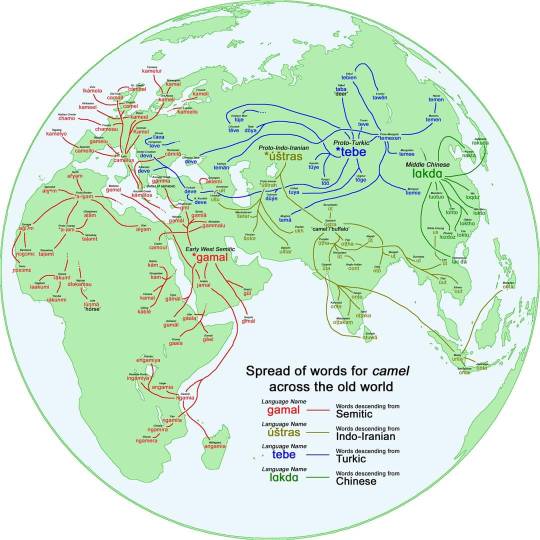
26 notes
·
View notes
Text
Map of British English dialects
by Ryan Starkey (Starkey Comics)
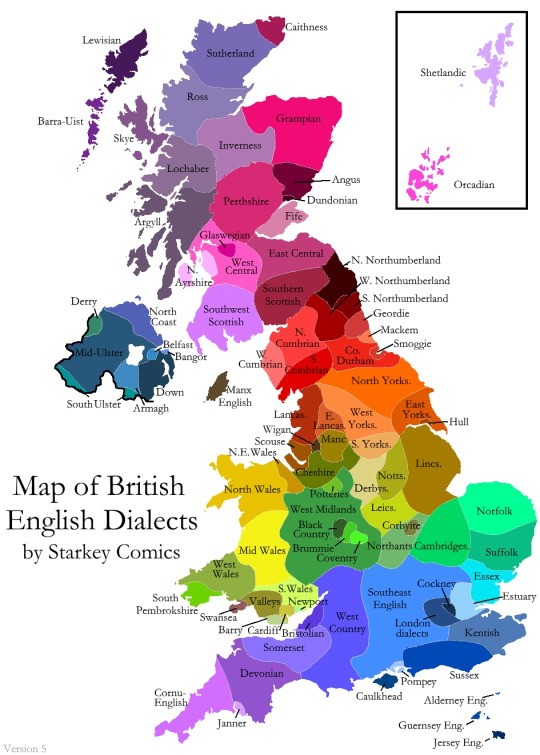
Author Ryan Starkey accompanies the map with a great article:
I’ve spent the last few years pooling together every study, survey, map, and database I can find, and then subjecting my image to several rounds of peer feedback. […] The end result is an image which is, to my knowledge, the most detailed map of British dialects ever made.
He also discusses “Why this map is wrong, and always will be”, and just how difficult it is to create a precise map of dialect regions.
Why is there so much dialect diversity in the U.K.? Because the longer a language is in a region, the more it tends to diversify. This is partly why, for example, there is a much larger variety of dialects spoken in the Eastern U.S. than the Western U.S.
Further Reading
The stories of English (David Crystal)
This is the perfect book to read if you want to know more about the history of dialect diversity in English, because the entire focus of the book is to show that English is not just one unified language (hence the plural “stories” in the title). It’s one of my favorite popular language books.
1K notes
·
View notes
Text

Table with the partinioning of the TREE-WOOD-FOREST semantic domain.
Georgakopoulos, Thanasis & Stéphane Polis. 2018. The semantic map model: State of the art and future avenues for linguistic research. Language and Linguistics Compass 12(2). e12270. https://doi.org/10.1111/lnc3.12270.
#table#semantics#Thanasis Georgakopoulos#Stéphane Polis#2018#Language and Linguistics Compass#semantic maps#typology#lingblr#linguistics
306 notes
·
View notes
Text

Hi there! I’m interested in how the meaning of "potato bug" varies by region, so I'm running a very short (~1 minute), anonymous survey to find out!
---SURVEY LINK---
You can complete the survey even if you've never heard of "potato bugs" before (but please indicate as much when prompted). Also, please be aware that the survey includes several photos of insects, so I'd advise against taking it if you're squeamish about bugs
Thanks and have a great day! :)
#Bugs#Insects#Potato bug#Potato bugs#Survey#Surveys#Entomology#Linguistics#Dialect Maps#Dialects#Polls#Research#Survey research#sC Original#Potato Bug Map#<- project tag#when I made my blog I never would've expected that bug-related dialect surveys would become a recurring theme but here we are
177 notes
·
View notes
Text

A map of Arabic dialects.
NizamNizamNizam:
FYI these are very different from one another. For example Hijazi to Egyptian would be like Texan english to Canadian, while Omani to Libyan would be like Jamaican Creole to Singlish.
(Source: industryarabic.com)
132 notes
·
View notes
Text
An isogloss, also called a heterogloss, is the geographic boundary of a certain linguistic feature, such as the pronunciation of a vowel, the meaning of a word, or the use of some morphological or syntactic feature. Isoglosses are a subject of study in dialectology, in which they demarcate the differences between regional dialects of a language; in areal linguistics, in which they represent the extent of borrowing of features between languages in contact with one another; and in the wave model of historical linguistics, in which they indicate the similarities and differences between members of a language family.
Wikipedia
57 notes
·
View notes
Photo
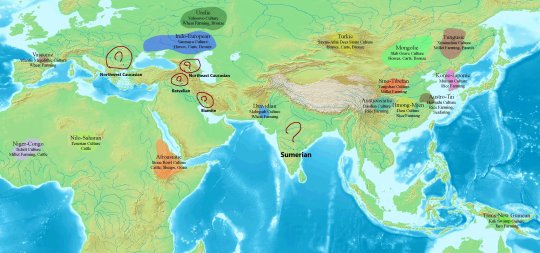
Map of Linguistic Homelands in the Old World.
151 notes
·
View notes
Text

The fact this map has "Chernihiv, Kharkiv, Dnipro, Luhansk, Kropyvnytsky".... but not Kyiv. XDDDDD
#linguistics#what a goddamn losers lmaooooo#Ukraine#stop russian aggression#support ukraine#genocide of ukrainians#russia is a terrorist state#maps
24 notes
·
View notes
Text

Extinct languages of the Mediterranean region.
#writeblr#writing#language#linguistics#extinct languages#fiction writing#novel writing#writing tips#mediterranea#vintage maps#cartography#mediterranean#likely incomplete#as with all maps
24 notes
·
View notes
Text


inspired by @reyneluvirith skyrim and fire emblem maps sent to me by my friend, maps depicting the sub and regional dialects of the northeast of the country Yaence.
Also featuring lakes and rivers too small to be included on my past world maps(but not the big interactive QGIS one ive been doing forever), major highway-type guys(though these are primarily used by forms of public transit), the borders of prefectures, and some major-ish cities in the area.
Some info about the cities pictured, and the dialect fuckery going on as well below the cut!
LANGUAGE AND DIALECT
Pictured in this map are two major languages that fall under the Tewenic language family, and are sister languages. Called Twac̊in̊(left) and Seșǔ(right), they linguistically are more akin to niece and aunt respectively, with the latter diverging from the Tewes protolanguage at the same time as the common ancestor of Twac̊in̊ and minority language Hetema. Due to this, the writing used by Seșǔ is closely related to that of Twac̊in̊ , but retains archaic artifacts of the abjad that was once used by Twac̊in̊ , and remains still in Hetema. Examples of these archaic letters include the use of the cluster t-w(fig. 1) instead of the single glyph tw(fig. 2), and the original m(fig. 3) glyph that fell out of use in Twac̊in̊ due to the sound being dropped altogether as a phoneme. Despite being the most widespread in the language family, Twac̊in̊ is the only member to have lost the /m/ sound.

The organization of the different subsections of language can get a little rough, especially since I've had this project since forever, but he's a basic chart to get you by:

Basically, language describes what I call all forms of the language, comparable to English as an entire language. Macrodialect refers to massive regions that all share similar overall differences. So English : American English = Twac̊in̊ : South H̊lanuel. From there, dialect or subdialect, used interchangeably, is across comparatively smaller areas, but still pretty big. Where macrodialects may cover an entire section of a continent, a dialect may only cover a country or two. Then down into regional dialects, which are within a country at their largest. Comparing to real life again, USA southern English : Atlanta area dialect = Suyal : Na Hel.
TWAC̊IN̊
The official language of the nation, and technically has a lot of overlap and overshadowing in the areas marked in the Seșǔ map, but that's not what I wanted to highlight with these maps. It is the language of majority across all three species that reside in the country: yotavuș, the native species, making up about 79% of the population of Yaence; humans, making up about 13%; and Keleŵu making up the rest. Yaence is a bit of an outlier in terms of human population outside of Earthspace :).
Featured in particular are the three of the four subdialects of macrodialect South H̊lanuel spoken in Yaence: Aeleh, Suyal, and N̊anec̊. Not pictured are Luatwed, found in the furthest western corner of the nation, and the In̊seh subdialects Lusus and Siyue to the south. The nation's most populated city, Ludu, as of the 2372 census, is often considered as the place with the "most correct" dialect in the country, and the word <Duyacin̊> implies a sense of being the everyman, "normal", and most importantly, Not Poor. One of my main characters born and mostly raised in the city actually has an accent in direct opposition to this, due to his parents raising him around people with accents from central parts of the country, areas considered to be less well-off.
SEȘǓ
Something extremely important, which you may have noticed in the maps themselves, is that the nation's capital is surrounded by one of the Seșǔ subdialects. More importantly, one of three subdialects that is native to Yaence, traditionally a non-Seșǔ country. This lends to a very... interesting accent in the people of Yasnae, which includes a muddling of the Twac̊in̊ /ʃ/, and the contrasting in Seșǔ of /ʃ/ and /s/ as the biggest offender noticed by other people in the country. Plenty of folks, in particular those in the western, less diverse regions of Yaence, look down on this accent as a degradation of the Twac̊in̊ language, and some extremist groups have put this fact forth as definitive proof that somewhere with an accent that better represents the majority of people(a touchy subject to the other people in the south and central regions that the westerners also look down on), namely, somewhere like Ludu or Nen̊in̊(not pictured).
EXTRA
See below for a chart with these places and language parts written in the native writing system. Also, keep in mind that while Twac̊in̊ and Seșǔ use the same base alphabet, there are diacritics and the aforementioned archaic letters in play. Think of it like how both English and Spanish use the Latin alphabet, but similar letters may represent different sounds, and some variations may exist in one language but not the other(ñ and rr in Spanish, /ʒ/ for the most part in English). If anyone has specific questions about the language-y side of stuff, feel free to DM or send an ask!
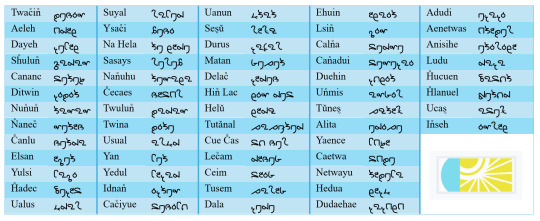
#worldbuilding#my post#that there art#map#worldbuilding map#linguistics#conlang#conlanging#twacin#sesu#HEHEHEHEHE#gets silly with it#even tho i bajoran and bhevown post a lot#twacin has my fav ocs in there#including The Polycule#and the mycomorph with his bf
18 notes
·
View notes
Text

A map of dialects and language variety differences of North America.
Key point: everyone has an accent. And that’s okay.
183 notes
·
View notes
Text
little maps 🗺️
The Latin word mappa meant ‘napkin, cloth’, but because maps were originally drawn on cloth, this eventually led to the word map 🗺️ as well.

Later, the /m/ in mappa changed to an /n/, giving rise the words nappy (a cloth) and napkin (a little cloth, with the diminutive -kin suffix, which also appears in the word lambkin ‘little lamb’ and possibly pumpkin ‘little melon’).
Old French also added a diminutive to this word, creating naperon ‘little cloth’, but English speakers reanalyzed the phrase a naperon as an aperon instead, and that gave rise to the modern word apron!
@mapsontheweb
96 notes
·
View notes
Text

A semantic map of the knowledge domain - different types of knowing/not knowing. Figure 1.2 on page 9 in:
Sjöberg, Anna. 2023. Knowledge predication: A semantic typology. Department of Linguistics, Stockholm University. https://urn.kb.se/resolve?urn=urn:nbn:se:su:diva-221698.
85 notes
·
View notes
Text

Hi, there! I'm running a short, anonymous survey about the common names used to describe a particular bug. All responses appreciated, even if you don't recognize the bug in the photo (just be sure to choose the "I am unfamiliar with this bug" option if that applies to you).
Survey link
Thanks and have a great day!
#Happy National Be Kind to Bugs Day! (July 14th)#Bugs#Bug#Insects#Insect#Survey#Surveys#Survey research#Data#Research#Linguistics#Entomology#That Bug#Bug Map#sC original
152 notes
·
View notes
Text
Atlas of The Boiling Isles: Archipelagos of the Left Thigh
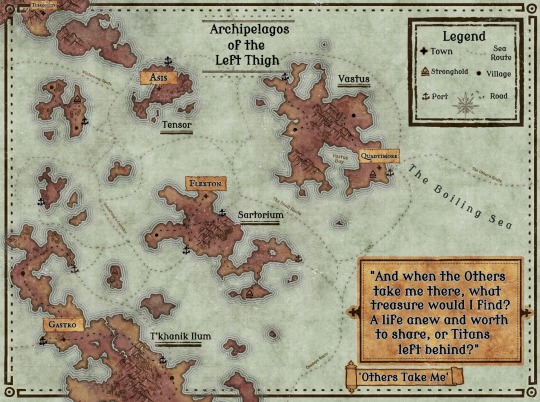
“Others take me from the Sea! Others take us Now! For we have seen what all is worth, so take us stern to bow!”
The Archipelagos of the Left Thigh, like many other regions, is rich in culture. The sea calls to these Witches and Demons and that is shown through their songs, ink, and sailing.
Two out of these three things have been considered 'Wild Magic'.
The sea still calls, and while former free waters are under watch by imposing Coven strongholds, the people of the left thigh, hum sorrow tunes in defiance. Raising their sails in hope the Others take them away.
Bonus!
Welcome to your first Old Tongue lesson! You’ve probably noticed on this map, that one of these Islands are not like the others.
T’khaník Ilum means ‘The Middle Ground’ in Old Tongue.
T‘khan (T-kAHN) means Ground or Base. Overtime as Common became the norm it can be mistakingly translated as Titan in Common Tongue.
Old Tongue also doesn’t follow the base English, Subject, Verb, Object (SVO) order. So for example, the sentence “Echorat eats paper” is SVO. In Old Tongue you can have “paper Echorat eats” (OSV) or “eats Echorat paper” (VSO). The reason for this is a thing called case endings.
Case Endings in Language are usually used to infer the Subject and Object within a flexible word order. The Agentive Case is used to indicate a subject in a transitive construction. -íf is the case ending for a word ending in a consonant, -f for a vowel ending. So the end case of T’khan to refer it as the subject it would be: T’khaníf
Patientive case is to infer the word is the Object in a sentence. It’s case endings are -ki (vowel ending word) and -ík (consonant ending word)
So if Ground was the object in a sentence it would be T’khaník
With this case endings you can have the word order wherever you like.
Ilum (Eh-Loom) means In between or middle.
The Isle of T’khaník Ilum, The Middle Ground. One of the very last areas to still keep its name in Old Tongue.
Fun fact! If you change where the glottal stop is (‘) on T’khan, it changes the word entirely.
Tkh’an (Tck–AN)=Time in the context of seeing growth. Be it age or crop.
79 notes
·
View notes
Photo
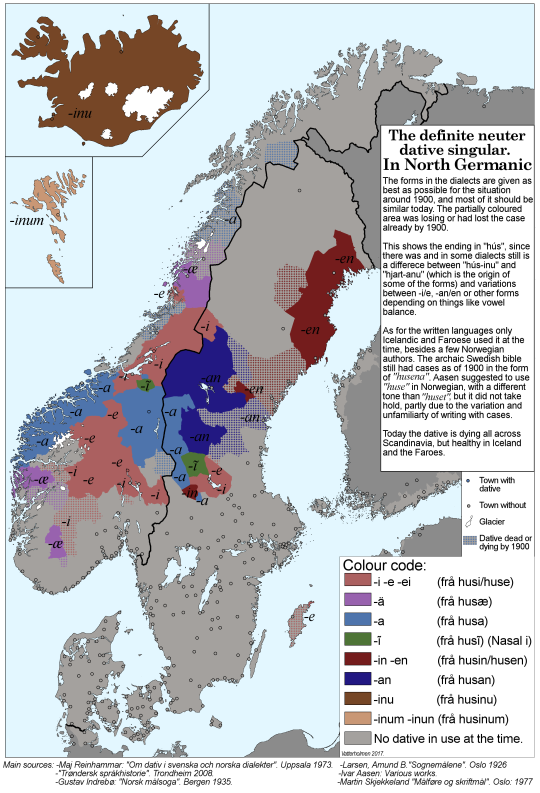
The definite dative ending of neuter nouns in North Germanic, from Old Norse "-inu", from "-i" + "-hinu".
The evolution:
Original Indefinte:
Proto Germanic: hūsai
Old English: hūse
Old Saxon: hūse
Older German: Hause
Old Norse: húsi
Adding a definite suffix:
Hinu Húsi > húsi hinu > húsinu (the house)
Later dialects
-inu > -in > -ĩ > -i
-inu > -in > -a(n) (from the weak ending or feminine) > -a > -æ
-inu > -in > -en > -e > -æ
-inu > -inum > -inun
-inu > -eno > -ena
In Written languages:
Lang.Form Icelandic:-inu Faroese:-inum Norwegian:Lacking (-e suggested) Swedish:Lacking (-ena in the bible until 1909) Danish:Lacking
by jkvatterholm
52 notes
·
View notes